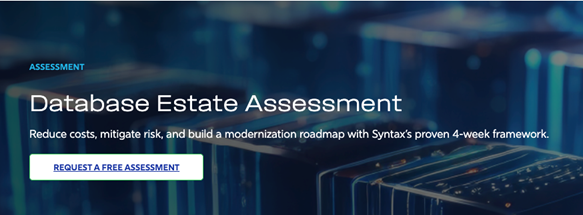Your enterprise is like a city: the bustling streets, billowing skyscrapers, crowded transit, and busy stores are for all to see, much like applications, services, and customer-facing interactions are the visible side of your operations. But what keeps a city running smoothly is largely beneath the surface: the power grid, water and sewage lines, upkept roads, and communication networks.
Build for Tomorrow
In an enterprise, the hidden infrastructure is the database environment. It’s what powers and connects everything your operation does, end-to-end. Like a city, a business can’t thrive with crumbling infrastructure. Much like a city conducting inspections to ensure buildings are up to code, enterprises should regularly assess the health of their database to understand where cracks are forming in their most crucial foundation.
Retrofitting, upgrading, and adding capabilities not only avoids future obstacles but also paves the way for new growth opportunities, innovative service solutions, and improved operational efficiency.
Database modernization isn’t simply an IT project. It’s an investment in availability, resilience, intelligence, security, and agility.
Upgrading your data foundation strengthens your ability to handle change, move fast, and innovate without compromise.
Even more, with Generative AI (GenAI) and Agentic AI revolutionizing how enterprises perform end-to-end workloads, such reinvention is only possible with a strong data foundation.
The Risks of Waiting to Modernize your Database
While the need to modernize is clear, many organizations delay because their current systems are still operational. In today’s economy, however, simply remaining operational isn’t enough, and, often, it’s an illusion.
Beneath the visible, bustling, seemingly well-run operation lies a foundation of accumulating risks and costs until they become unavoidable obstacles.
Such obstacles may include:
- Higher Risk: End-of‑-life‑ databases lose vendor support, leaving you exposed to security, compliance, and operational risks.
- Security Gaps: Legacy systems lack the embedded security controls and automated defenses available in modern releases.
- Performance Limitations: Older platforms choke on modern workloads—particularly AI-driven‑ analytics, hybrid deployments, or spikes in demand.
- Database Sprawl: Over time, organizations accumulate fragmented, redundant, or siloed databases, which lack proper governance, suffer from poor software license compliance, and result in much higher operating costs due to varying skillsets that may be required.
- Higher Ongoing Costs: More databases on more technology platforms means more maintenance, higher likelihood of maintenance downtimes, and high licensing fees for outdated tech, and the constant workarounds add hidden strain to budgets.
- Limited Recoverability: Most organizations that find themselves in operational chaos are much less likely to test high availability and disaster recovery procedures, which could result in massive financial loss to your business, or worse yet, reputation damage due to a preventable ransomware event.
If we go back to the city analogy, operating a modern city with 1950s-era utilities would be untenable—from the electricity demands to the sanitation requirements. Over time, every outage, inefficiency, and repair costs more and delivers less value, and that makes it more difficult for you to deliver your products and services to your customers. The same happens with your infrastructure for databases. So, where do we start?
A database estate assessment is the fastest and most dependable way to uncover risks and map the right path forward.
It will help you understand the types and versions of technology, any associated software vulnerabilities, topology and performance information, and licensing position. Beyond that, it will help you understand which technologies make the most sense for your business and how you can operate them more efficiently, all with an eye towards meeting your business goals.
The AI-Accelerated Reality for Database Platforms
Challenges pave the path to modernization, but nothing has accelerated the urgency to move forward quite like AI. New standards like Model Context Protocol (“MCP”) are a game-changing solution to provide AI-enabled connectivity into traditional databases, but it can create stress on legacy systems. More modern database platforms enable this technology by default to help accelerate your access to the data in traditional data stores.
As businesses that were slow to adopt video conferencing or e-commerce in years past struggled, so will businesses who don’t modernize their databases to optimize AI workloads. The traditional role of the database administrator is evolving, with newer database technologies providing more autonomous capabilities, thus allowing the “DBA” to become more of a “data steward” and an enabler of embedding AI technology in your data.
The New Demands on the Data Layer
The database is the nerve center of the enterprise, and the demands are only increasing:
- Hybrid/Multicloud Agility: Businesses need the ability to run workloads across Oracle Cloud Infrastructure (OCI), Amazon Web Services (AWS), Azure, and on-premise, wherever it makes most business sense. More organizations are choosing to replicate data across cloud providers for the purpose of backups, reporting, and recovery and to diversify risk.
- Regulatory Compliance: As AI, privacy, and data protection laws evolve—and differ—across regions, databases must offer embedded auditing, data lineage tracking, and access control that can adapt without costly rewrites.
- Unified Data Access: Breaking down silos to access real-time analytics and Machine Learning so decision-making isn’t slowed by fragmented datasets.
- Modern Architecture for Change: Cloud-native, containerized, and elastic solutions expand and adapt with changing market needs.
Building the Modern Database Foundation
A modern database platform isn’t one thing. It’s an integrated set of capabilities designed to scale, protect, and enable innovation. Key enablers include:
- Oracle Database 23ai: Autonomous operation, AI/ML integration, advanced JSON and graph data handling, and better developer productivity.
- Exadata and Cloud Native Options: Industry-leading performance for mission-critical workloads, with flexibility to deploy in the public cloud, on-prem, or hybrid.
- Cyber Resilience: Built-in high availability, disaster recovery, and Zero Data Loss technologies to ensure business continuity.
- Multicloud Optimization: Run workloads where they give the best performance and cost value, while governing data consistently.
- Manageability and Automation: Reduce administrative overhead and speed up provisioning, scaling, and updates.
- Reducing Dependence on Single-Purpose Databases: Simplify sprawling data environments into unified, secure, and cost-optimized‑ database footprints.
Cyber Resilience and Disaster Recovery in OCI
Acting Now in Database Modernization Pays Off
Database modernization isn’t simply about future readiness. It’s about the business bottom line, and it offers immediate and compounding ROI. It accelerates time-to-value by turning data into actionable insight faster, laying the foundation for AI-driven innovation. It strengthens cyber resilience to reduce both the financial and reputational impact of outages or breaches. It increases agility, enabling rapid responses to market shifts, customer demands, and new opportunities.
Most importantly, it drives over cost savings by optimizing licensing, lowering infrastructure and hosting expenses, and reducing the manual workload required to keep systems running.
Waiting may seem like saving money, but in practice, it’s leaving innovation and efficiency gains on the table for your competitors’ taking.
Syntax is the Outcome-Driven‑ Data Modernization Partner
At Syntax, we understand that database modernization is not a one-size‑-fits‑-all‑ solution. In modernizing, each organization will confront different and unique challenges.
Our approach is tailored to those unique challenges and your specific goals:
| Assessment → Modernization → Optimization → continual Managed Services to ensure value, not just deployments. |
| Expertise that spans all database modernization needs, including consolidation, cloud migration, cyber resilience, GenAI enablement, MongoDB takeout, and automation. |
| A focus on business results such as speed, performance, security, and cost optimization custom-made to your industry realities. |
Think of Syntax as your data architects and engineers, modernizing your foundation so it’s ready not only for the challenges of today but also for the innovations of tomorrow.
Database modernization should no longer be a reactive decision made in desperation. It should be a strategic choice to position your business to thrive in this AI-powered, multicloud, regulation-intensive economy.
Ready to take the first step toward modernizing? Start with Syntax’s Database Estate Assessment at no cost and zero risk to understand where your foundation stands today and the fastest, custom-made path to modernization and AI readiness.
Looking for more information on the power of database modernization? Check out our webinar on the power of Oracle Database 23ai.
Exploring a move to the cloud? Discover your journey with our Cloud Assessment Tool for a tailored path forward with Syntax.
Author

Marc Caruso
Chief Architect at Syntax
Marc Caruso is a visionary technology executive and Chief Architect at Syntax, with over 25 years of experience in enterprise transformation, cloud modernization, and ERP innovation. An expert in multicloud (AWS, Azure, GCP, OCI), Oracle, SAP, and AI/GenAI, Marc helps global organizations align technology strategy with business goals to drive measurable value and competitive advantage.



